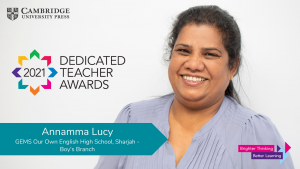Presentation highlights from IATEFL 2016
Among the presentation highlights from IATEFL 2016, by far the most talked about session this year was Silvana Richardson’s plenary ‘The “native factor”, the haves and the have-nots’, and rightly so.
Silvana started by telling us what she was not: not male, not tall, not single, not a fantasy buff, and not a native-speaker English teacher. As she pointed out, this is a crazy way to introduce yourself, and it is in no way meaningful or constructive. It shuts out over 80% of the English teachers in the world.
Over the course of the next sixty minutes, Silvana proceeded to tell us about the history of the rise of native speakerism and debunk a whole series of myths about the logical fallacy that is the dominance of the native speaker in many markets. She showed how favoring somebody with no experience or qualifications but who is a ‘native speaker’, over a qualified L2 (second language/bilingual) English speaker with first-hand experience of learning the language is damaging for our profession. She also gave a series of suggestions for teachers, trainers and recruiters to show what we can all do to help end this discrimination.
At the end of the plenary, Silvana proudly told us that she is multilingual, grew up speaking Spanish and is from an Italian family. This is her identity, and it does not make her in any way a lesser English teacher than somebody who happens to have grown up speaking English.
As Jim Scrivener tweeted afterwards, this was IATEFL’s ‘I have a dream’ plenary, and I hope its message continues to be heard. If you missed the plenary, you can watch it online at https://iatefl.britishcouncil.org/2016/session/plenary-silvana-richardson. You can also read more information about ending discrimination on the TEFL Equity Advocates site: https://teflequityadvocates.com/
Variations on a theme
Apart from Silvana’s plenary, there were a few other talks related to making our industry fairer and acknowledging other varieties of English more. There were two which particularly stood out for me.
The first was by Lewis Lansford, highlighting how TED talks done by non-native English speakers could be a springboard for discussion about cultural differences, and raising awareness of different English accents from around the world. They can also be used to show learners that it doesn’t matter if you make occasional mistakes, providing that your aim of communicating your message is met.
The second was by Damian Williams, who suggested a ‘Language Teachers Development toolkit’, designed to help L2 English-speaking teachers to improve their own language proficiency so that they can feel more confident in the classroom, and perhaps also get more opportunities at work, for example being able to teach higher-level classes.
A pleasant surprise
When you see so many good talks in just a few days, it can be hard to select the highlights, but one presentation was a standout for me because I chose it entirely on the basis of the name and had no idea what to expect.
Matilda Wong from the University of Macau gave a presentation entitled ‘Images of teaching: a tool for reflective teacher learning’. She works on a four year B.Ed. programme for secondary school teachers. In their final year, they do two one-month placements in secondary schools, combined with support from tutors to reflect on their experiences.
Matilda noticed that written journals were not always useful tools to do this, as they could increase the pressure on trainees and they didn’t always know what to write. Instead she experimented with drawing, as when she had tried this herself during her PhD it had had a profound effect on her.
Before their first practicum, she asked trainees to draw a picture of an ideal classroom, and annotate it with information about what the teacher and students are doing and saying. This brought various beliefs to light that it would have been difficult for the teachers to articulate in writing or speaking. Examples included three trainees who drew teachers with smiling faces, emphasizing the need to be friendly, and one who forgot to include a teacher in the image at all, and didn’t notice until it was pointed out to her later.
However, by far the most surprising image for me was the only one which used colour. Teachers in Macau are Cantonese, and may speak Portuguese as well due to the colonial history. In this picture, the Cantonese teacher had drawn a blonde, white teacher who looked nothing like her. Matilda did not notice this until the audience in the session pointed it out to her. It was a sad echo of the all-too-common lack of confidence expressed by some L2 speakers of English in their right to teach.
The idea of using drawing to uncover deeper thoughts about what a teacher believes is one I will definitely use in future training I do, and I just wish the session had had a few more than ten people in it!
Inclusivity in the classroom
In an unrelated area, there also seemed to be more talks about helping students with SEN (Special Educational Needs) in the programme this year, and this is reflected in the proposal for a new IATEFL SIG (Special Interest Group), focused on Inclusive Practice and SEN. If you’re interested in joining, please visit https://mercedesviola.wordpress.com/2016/04/11/new-proposed-iatefl-sig-inclusive-practices-and-sen-special-educational-needs/ to find out more.
Marie Delaney’s talk on the challenges and opportunities of teaching students with SEN was particularly useful. In it, she gave a series of practical tips for understanding SEN, communicating with students and parents, and supporting learners as much as possible in the classroom. I am currently halfway through her new book, Special Educational Needs, from the OUP series Into the Classroom. I would definitely recommend getting yourself a copy, as her tips are very straightforward, easy to apply and should help all of your students, not just those with SEN.
The best bits
As I said before, it can be difficult to choose which talks to include in a selection of highlights, but I hope I have given you an idea of some of the sessions which most resonated with me. I have written a series of posts on my blog covering the talks I attended in more detail and highlighting some of the ones that I missed. I would urge you to have a look at my summary https://sandymillin.wordpress.com/iatefl16summary/, along with the excellent British Council coverage of the event, now in its tenth year: http://iatefl.britishcouncil.org/2016 I hope to see you in Glasgow next year!
Sandy blogs at http://sandymillin.wordpress.com




